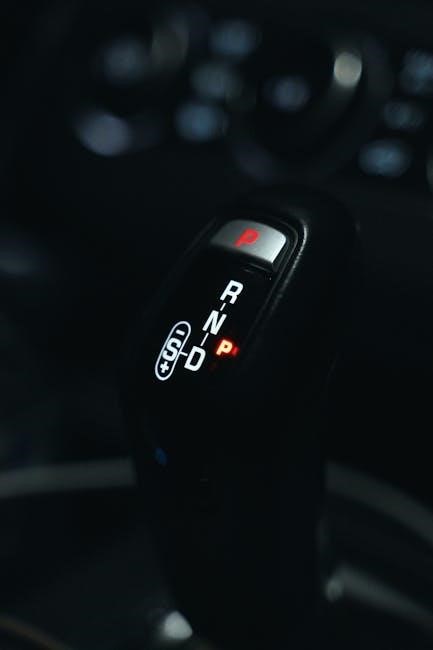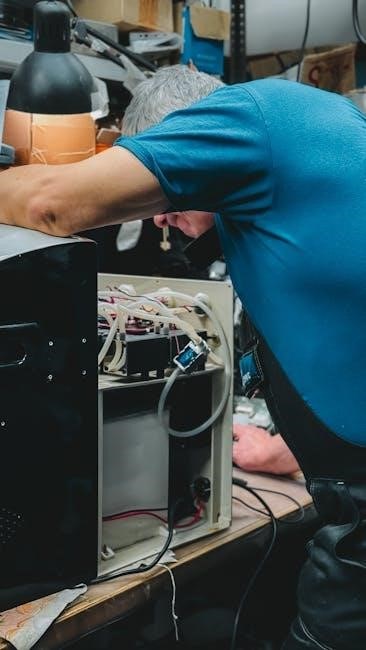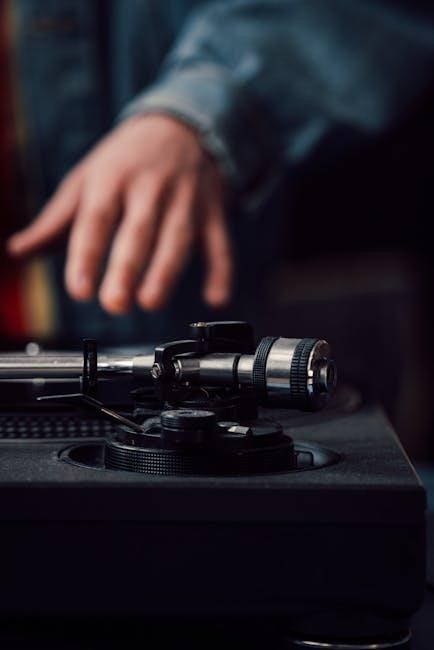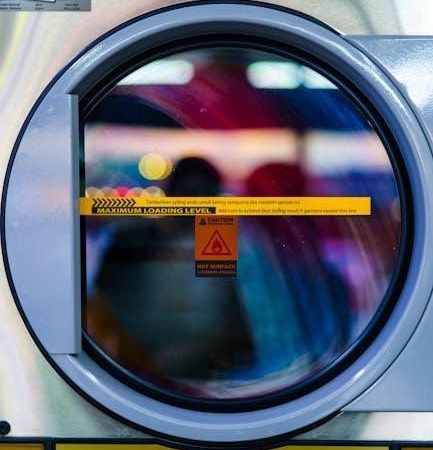Manual and automatic turntables cater to different audiophile preferences, offering unique benefits. Manual turntables provide precise control appealing to purists, while automatic models offer convenience for casual listeners. Explore their differences to choose the best fit for your vinyl journey and sound preferences.
Overview of Turntable Types
Turntables are primarily categorized into manual and automatic models, each designed to cater to distinct user preferences. Manual turntables require users to lift and place the tonearm manually, offering precise control over playback. Automatic turntables, on the other hand, feature mechanisms that start and stop the record automatically, providing convenience for casual listeners. Both types vary in terms of features, build quality, and cost, making them suitable for different audiophile needs. While manual turntables are often praised for their customizable settings and high-end materials, automatic models are valued for their ease of use and accessibility. Understanding these differences helps users choose the right turntable for their vinyl experience.
Importance of Choosing the Right Turntable
Choosing the right turntable is crucial for an optimal vinyl listening experience. The decision between manual and automatic models impacts sound quality, convenience, and overall satisfaction. Manual turntables offer precise control and are often preferred by audiophiles for their ability to customize settings, ensuring a high-fidelity sound. Automatic turntables, however, provide ease of use, making them ideal for casual listeners who value convenience. The correct choice also depends on budget, as prices vary significantly between models. Selecting a turntable that aligns with personal preferences ensures longevity and enjoyment of your vinyl collection. It’s essential to consider these factors to make an informed decision tailored to your lifestyle and listening habits.

Basics of Manual Turntables
Manual turntables require users to lift and place the tonearm manually, offering precise control over playback. They are favored by audiophiles for their superior sound quality and tactile experience.

What Is a Manual Turntable?
A manual turntable is a type of record player that requires the user to manually lift and place the tonearm onto the record. Unlike automatic models, it lacks automation features, giving listeners full control over playback. This design appeals to audiophiles who value precise control and a more hands-on, tactile experience. Manual turntables often feature adjustable settings, such as tracking force and anti-skate, allowing for fine-tuning to optimize sound quality. They are typically associated with higher fidelity and a more immersive listening experience, making them a preferred choice for vinyl enthusiasts seeking authenticity and connection to their music.

How Manual Turntables Operate
Manual turntables require users to perform several steps to play records. First, the record is placed on the platter, and the tonearm is lifted and manually positioned over the desired track. Once the needle is lowered, the motor spins the record. At the end of the side, the listener must lift the tonearm and return it to its rest position. This hands-on process allows for precise control and minimizes wear on the needle and record. While manual operation requires more attention, it often results in better sound quality and longevity of both the record and the equipment, appealing to audiophiles who value precision and care in their vinyl experience.

Basics of Automatic Turntables
Automatic turntables simplify vinyl playback with features like auto-start and stop, making them user-friendly. They lift and lower the tonearm automatically, reducing manual intervention and potential wear.
What Is an Automatic Turntable?
An automatic turntable is a device designed to play vinyl records with minimal user intervention. It features mechanisms that automatically lift and lower the tonearm, start playback, and stop once the record ends. This design makes it more convenient for casual listeners who prefer a hands-off experience. Unlike manual turntables, automatic models simplify the process, reducing the need for manual adjustments. They are ideal for those who want to enjoy vinyl without the technical intricacies, offering a seamless and user-friendly listening experience. Automatic turntables cater to a broader audience, including newcomers to vinyl, by eliminating the need to handle the tonearm manually.
Key Features of Automatic Turntables
Automatic turntables are designed for simplicity and convenience, offering features like a motorized tonearm that lifts and lowers automatically. They often include an auto-start function, beginning playback with the touch of a button, and auto-stop, which lifts the needle at the record’s end. Many models feature built-in phono preamps for direct connection to speakers or amplifiers. Some automatic turntables also offer multiple speed settings (33, 45, and 78 RPM) to accommodate various record sizes. Additionally, USB connectivity is common, allowing users to digitize their vinyl collections. These features make automatic turntables user-friendly and accessible, especially for those new to vinyl or seeking a hassle-free listening experience.
Comparison of Features

Manual vs automatic turntables differ in ease of use, sound quality, and durability; Manuals offer precise control, while automatics provide convenience, making each suited for distinct listening preferences.
Ease of Use: Manual vs Automatic

Manual turntables require users to lift and place the tonearm manually, offering a tactile experience for vinyl enthusiasts. Automatic turntables simplify the process with features like auto-start and auto-return, making them more convenient for casual listeners. Manuals demand attention, as users must monitor record endings to avoid needle wear, while automatics handle these tasks seamlessly. This difference caters to distinct preferences: manual for purists seeking control and automatic for those prioritizing ease. The choice ultimately depends on whether convenience or hands-on involvement is more important to the listener. Both options enhance the vinyl experience but cater to different lifestyles and listening habits.
Sound quality differs slightly between manual and automatic turntables, though both can deliver excellent audio. Manual turntables often provide a more precise listening experience due to the direct control over the tonearm placement, reducing potential mechanical interference. Automatic turntables, while convenient, may introduce slight motor noise or mechanical movement that can affect sound purity. High-end automatic models minimize these issues, but manual turntables are generally preferred by audiophiles for their potential to offer a cleaner, more immersive sound. The choice depends on whether sound fidelity or convenience is prioritized, as both types can satisfy listeners seeking quality audio experiences tailored to their preferences and lifestyle.
Manual and automatic turntables vary in price, with manual models often being more affordable due to simpler mechanisms. Automatic models, offering convenience features like auto-start and stop, tend to be pricier but provide added functionality. Both options offer good value, catering to different budgets and preferences, ensuring listeners can find a quality turntable that fits their needs and enhances their vinyl listening experience. Manual turntables are generally more affordable, with entry-level models starting around $100. Mid-range options, offering better build quality and features like adjustable tracking force, typically cost between $300 and $600. High-end manual turntables, crafted with premium materials and precise engineering, can range from $1,000 to several thousand dollars. Vintage manual turntables, sought after by collectors, can vary widely in price depending on condition and rarity. Overall, manual turntables provide excellent value for vinyl enthusiasts, balancing cost with performance and durability, making them a popular choice for both beginners and seasoned audiophiles alike. Their pricing ensures accessibility across various budgets. Automatic turntables are often more expensive than their manual counterparts, with entry-level models starting around $200. Mid-range automatic turntables, offering features like fully automatic operation and improved sound quality, typically range from $400 to $800. High-end automatic models, equipped with advanced features and premium materials, can cost between $1,200 and $3,000. Vintage automatic turntables, particularly those in excellent condition, can fetch higher prices, sometimes exceeding $2,000. While automatic turntables may have a higher initial cost, they offer convenience and ease of use, making them a worthwhile investment for those who value simplicity and hands-free operation without compromising on sound quality. Their pricing reflects the added technology and engineering. Manual turntables often feature solid wood or metal constructions, emphasizing durability and resonance control. Automatic turntables may include plastic components but still use high-quality materials for key parts. Manual turntables are typically crafted from high-quality materials like solid wood, aluminum, or steel, ensuring durability and optimal sound reproduction. Automatic turntables often feature materials like plastic, aluminum, and engineered wood, balancing affordability with performance. Manual and automatic turntables each offer unique advantages, catering to different preferences and lifestyles. manual models provide precise control for audiophiles, while automatic turntables offer convenience for casual listeners. When deciding between a manual and automatic turntable, consider your lifestyle and priorities. Manual turntables are ideal for audiophiles who value precise control and high sound quality, while automatic models offer convenience for casual listeners. Budget and build quality also play a role, as manual turntables often require a higher investment but may last longer. Automatic turntables are more accessible and user-friendly, making them perfect for those who want to enjoy vinyl without the hassle. Ultimately, the choice depends on whether you prioritize sound fidelity, ease of use, or a balance of both. Choose wisely to enhance your vinyl listening experience.Sound Quality: Manual vs Automatic
Cost and Value
Price Range for Manual Turntables
Price Range for Automatic Turntables

Build Quality and Materials
Materials Used in Manual Turntables
The plinth, often made of wood or metal, provides stability and minimizes vibrations.
The tonearm is usually aluminum or carbon fiber, designed for precision and balance.
These materials enhance sound quality and longevity, making manual turntables a preferred choice for audiophiles seeking a premium listening experience.Materials Used in Automatic Turntables
The plinth may be made of durable plastic or wood, while the tonearm is typically aluminum for lightweight and precise movement.
Some models incorporate metal components for added stability, though they may lack the premium feel of manual turntables.
These materials ensure automatic turntables are both functional and cost-effective, appealing to casual listeners who prioritize convenience without compromising sound quality.Final Thoughts on Manual vs Automatic Turntables

